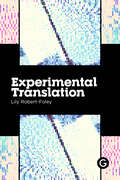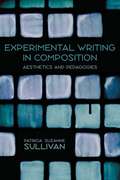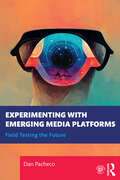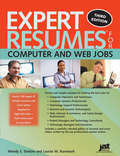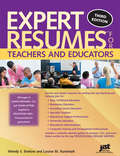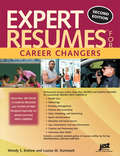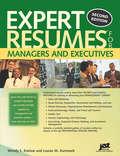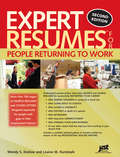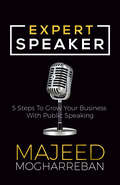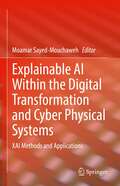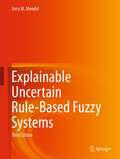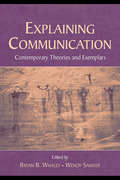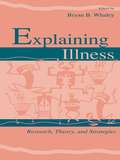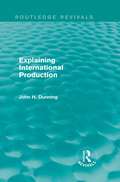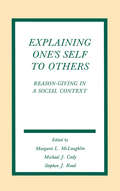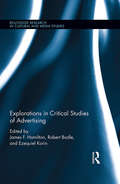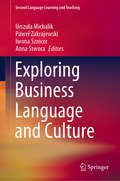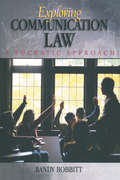- Table View
- List View
Experimental Translation: The Work of Translation in the Age of Algorithmic Production (Practice as Research)
by Lily Robert-FoleyThe history and future of an alternative, oppositional translation practice.The threat of machine translation has given way to an alternative, experimental practice of translation that reflects upon and hijacks traditional paradigms. In much the same way that photography initiated a break in artistic practices with the threat of an absolute fidelity to the real, machine translation has paradoxically liberated human translators to err, to diverge, to tamper with the original, blurring creation and imitation with cyborg collage and appropriation. Seven chapters reimagine seven classic &“procedures&” of translation theory and pedagogy: borrowing, calque, literal translation, transposition, modulation, equivalence, and adaptation, updating them for the material political and poetic concerns of the contemporary era. Each chapter combines reflections from translation studies and experimental literature with practical guides, sets of experimental translation &“procedures&” to try at home or abroad, in the classroom, the laboratory, the garden, the dance hall, the city, the kitchen, the library, the shopping center, the supermarket, the train, the bus, the airplane, the post office, on the radio, on your phone, on your computer, and on the internet.
Experimental Writing in Composition: Aesthetics and Pedagogies
by Patricia Suzanne SullivanSullivan unpacks the work of major scholars in composition and rhetoric and their theories on aesthetics, particularly avant-gardism. She also relates the dialectics that shape these aesthetics and sheds new light on both the positive and negative aspects of experimental writing and its attempts to redefine the writing disciplines. Additionally, she shows how current debates over the value of multimedia texts echo earlier arguments that pitted experimental writing against traditional models. Sullivan further articulates the ways that multimedia is and isn’t changing composition pedagogies, and provides insights into resolving these tensions.
Experimenting with Emerging Media Platforms: Field Testing the Future
by Dan PachecoExperimenting with Emerging Media Platforms teaches students in media tracks – journalism, advertising, film, and public relations – how to independently field test and evaluate emerging technologies that could impact how media is produced, consumed, and monetized in the future. Taking a unique trial-and-error approach, the author encourages students to go against their desire for perfection and instead plunge into exercises with the full expectation that they will "fail" many times before they succeed. Through focused assignments, this book provides pointers on how to familiarize oneself with current technology, including extended reality (XR, VR, AR, and MR), open-source coding, photogrammetry, aerial imagery using drones, automation, and artificial intelligence. Readers are invited to create and test their own hypotheses and work outside of their comfort zones to reach conclusions on how a technology could enhance storytelling for a particular audience. Through experimentation guided by workbook exercises, case studies from students and media practitioners, practical tips, and reminders about ethical decision-making, students will learn how to work like explorers and civic hackers to enact change in the media landscape. Readers are invited to share their final field test results online through the book's companion website and social media channels, where the author will post links to further reading, coding templates for simple projects, and short video tutorials. Built around an established course being taught by the author and informed by over 20 years’ experience in media industries, Experimenting with Emerging Media Platforms is essential reading for aspiring media professionals and students undertaking courses such as Emerging Media, Media Innovation, and Media Startups. For additional resources, please see the companion website: www.emergingmediaplatforms.com.
Expert Microsoft Teams Solutions: A guide to Teams architecture and integration for advanced end users and administrators
by Aaron Guilmette Yura Lee Grant Oliasani Angel AvilesWritten by Microsoft engineers, Expert Microsoft Teams Solutions covers in-depth topics in Teams that are not covered elsewhere and explores tasks that customers frequently rely on Microsoft Partners to accomplishKey FeaturesExtend the MS Teams experience with this practical guide from Microsoft's technical specialistsDiscover advanced Teams capabilities such as voice, governance, and Power Platform integrationGet to grips with planning resources for voice integration in TeamsBook DescriptionMicrosoft Teams is designed to improve collaboration and integrate components of SharePoint, Exchange, Power Platform, and voice calling into a single platform. Complete with step-by-step explanations of concepts, practical examples, and architecture guidance, you'll learn how to plan and deploy Teams for your organization. As you progress, you'll explore and understand the Teams platform as a whole, from architecture and collaboration through to apps and voice, with the help of examples. The book approaches Teams not only from an end-user perspective but also from an administrator's point of view. You'll be able to understand the challenges around modernization in your organization relating to adopting, implementing, and administering Teams and tackle them effectively. By helping you realize the potential of Teams as a platform, this book will enable you to set up and deploy Teams solutions, leading to modernization in your organization's chat and voice infrastructure. By the end of this book, you'll be able to design and implement the most important and exciting aspects of Microsoft Teams.What you will learnGain a clear understanding of Microsoft Teams architecture and deployment conceptsBecome well-versed with advanced Teams voice capabilitiesExplore best practices to extend the Teams experience to various apps through collaborationFocus on how to conduct effective meetings, including ad hoc, scheduled, channel, and live eventsIntegrate Power Apps and Power Automate with Microsoft TeamsUnderstand key governance and security concepts in administering Microsoft TeamsWho this book is forThe book is for intermediate-level and experienced Microsoft Teams IT professionals as well as for administrator roles. Intermediate-level knowledge of the Microsoft Teams platform is assumed.
Expert Resume for Computer & Web Jobs
by Louise Kursmark Wendy EnelowFeatures an extensive collection of sample resumes and cover letters for computer, Web, and IT professionals.
Expert Resume for Health-Care Careers
by Louise Kursmark Wendy EnelowDozens of professional resume writers share their secrets or sample resumes, revealing how to start and advance a medical or health care career.
Expert Resume for Teachers and Educators
by Louise Kursmark Wendy EnelowA comprehensive collection of sample resumes and cover letters for teachers and educators written by some of the nation's most acclaimed professional resume writers.
Expert Resumes for Career Changers
by Louise Kursmark Wendy EnelowFeatures a collection of outstanding professionally written resumes designed for people transitioning into a new career.
Expert Resumes for Managers and Executives
by Louise Kursmark Wendy EnelowA vast and varied collection of hundreds of attractive and effective resumes, written by professional resume writers and targeted to front-line, middle management, and upper-management professionals.
Expert Resumes for Military-to-Civilian Transitions
by Louise Kursmark Wendy EnelowShows veterans exactly how to market their skills and experience and translate them into language their resume readers will understand.
Expert Resumes for People Returning to Work
by Louise Kursmark Wendy EnelowA collection of professionally written resumes aimed at anyone who has left work for a period of time and then wanted to return.
Expert Speaker: 5 Steps To Grow Your Business With Public Speaking
by Majeed MogharrebanFor those looking to become a highly-paid speaker who makes a difference, Expert Speaker reveals how to take the stage by being an expert, not the expert. The fastest way to build authority, get one’s name out to the public, and attract premium clients is by public speaking. The truth is, not just any speech will win stages and attract the right clients. In Expert Speaker, ExpertSpeaker.com founder Majeed Mogharreban draws from his ten years of experience as a professional speaker to help readers build their brands, grow their business, and amplify their message in a way that makes a difference. Expert Speaker teaches those who are serious about public speaking what to say to get booked, how to give a speech that builds authority, how to negotiate their speaker fee, and so much more. Majeed walks readers through every aspect of public speaking so they too can amplify their message and take control over the big stage of their career.
Explainable AI Within the Digital Transformation and Cyber Physical Systems: XAI Methods and Applications
by Moamar Sayed-MouchawehThis book presents Explainable Artificial Intelligence (XAI), which aims at producing explainable models that enable human users to understand and appropriately trust the obtained results. The authors discuss the challenges involved in making machine learning-based AI explainable. Firstly, that the explanations must be adapted to different stakeholders (end-users, policy makers, industries, utilities etc.) with different levels of technical knowledge (managers, engineers, technicians, etc.) in different application domains. Secondly, that it is important to develop an evaluation framework and standards in order to measure the effectiveness of the provided explanations at the human and the technical levels. This book gathers research contributions aiming at the development and/or the use of XAI techniques in order to address the aforementioned challenges in different applications such as healthcare, finance, cybersecurity, and document summarization. It allows highlighting the benefits and requirements of using explainable models in different application domains in order to provide guidance to readers to select the most adapted models to their specified problem and conditions.Includes recent developments of the use of Explainable Artificial Intelligence (XAI) in order to address the challenges of digital transition and cyber-physical systems;Provides a textual scientific description of the use of XAI in order to address the challenges of digital transition and cyber-physical systems;Presents examples and case studies in order to increase transparency and understanding of the methodological concepts.
Explainable Machine Learning in Medicine (Synthesis Lectures on Engineering, Science, and Technology)
by Karol Przystalski Rohit M. ThankiThis book covers a variety of advanced communications technologies that can be used to analyze medical data and can be used to diagnose diseases in clinic centers. The book is a primer of methods for medicine, providing an overview of explainable artificial intelligence (AI) techniques that can be applied in different medical challenges. The authors discuss how to select and apply the proper technology depending on the provided data and the analysis desired. Because a variety of data can be used in the medical field, the book explains how to deal with challenges connected with each type. A number of scenarios are introduced that can happen in real-time environments, with each pared with a type of machine learning that can be used to solve it.
Explainable Uncertain Rule-Based Fuzzy Systems
by Jerry M. MendelThe third edition of this textbook presents a further updated approach to fuzzy sets and systems that can model uncertainty — i.e., “type-2” fuzzy sets and systems. The author demonstrates how to overcome the limitations of classical fuzzy sets and systems, enabling a wide range of applications, from time-series forecasting to knowledge mining to classification to control and to explainable AI (XAI). This latest edition again begins by introducing classical (type-1) fuzzy sets and systems, and then explains how they can be modified to handle uncertainty, leading to type-2 fuzzy sets and systems. New material is included about how to obtain fuzzy set word models that are needed for XAI, similarity of fuzzy sets, a quantitative methodology that lets one explain in a simple way why the different kinds of fuzzy systems have the potential for performance improvements over each other, and new parameterizations of membership functions that have the potential for achieving even greater performance for all kinds of fuzzy systems. For hands-on experience, the book provides information on accessing MATLAB, Java, and Python software to complement the content. The book features a full suite of classroom material.
Explaining Communication: Contemporary Theories and Exemplars (Routledge Communication Series)
by Bryan B. Whaley Wendy SamterOffering a direct sightline into communication theory, Explaining Communication provides in-depth discussions of communication theories by some of the foremost scholars working in communication today. With contributions from the original theorists and scholars known for their work in specific theoretical perspectives, this distinctive text breaks new ground in giving these scholars the opportunity to address students firsthand, speaking directly to the coming generations of communication scholars. Covering a wide range of interpersonal communication theories, the scope of this exceptional volume includes:*the nature of theory and fundamental concepts in interpersonal communication;*theories accounting for individual differences in message production; explanations of human communication from dyadic, relational, and/or cultural levels; and*a history of communication theory. Chapter authors offer their own views of the core ideas and findings of specific theoretical perspectives, discussing the phenomena those perspectives are best positioned to explain, how the theories fit into the field, and where future research efforts are best placed. While by no means comprehensive, Explaining Communication includes those theories that rank among those most often used in today’s work, that have generated a substantial body of knowledge over time, and that have not been articulated in detail in other publications. With detailed explorations and first-hand discussions of major communication theories, this volume is essential for students in communication studies, interpersonal communication, and advanced theory courses, as well as for scholars needing a thorough reference to some of the most salient theories in communication today.
Explaining Illness: Research, Theory, and Strategies (Routledge Communication Series)
by Bryan B. WhaleyUnderstanding one's health conditions plays a key role in a patient's response to illness, influencing stress levels and the likelihood of following treatment regimens and advice. Thus, the explanation of illness is a critical component of the interactions between health care providers and their patients. Emphasizing these exchanges and their potential for improving health and well being, Bryan B. Whaley has assembled this collection to serve both as a foundation for further research on explaining illness and as a resource for provider-patient interaction. Contributors from the communication and health care disciplines examine the purpose and methods of explaining illness, as well as the role that illness explanations play in framing and reframing meaning and uncertainty regarding one's health welfare. Including theoretical, developmental, and cultural factors, the elegance of this book is the richness in the differences among populations and communication strategies, and the articulation of the intricacies of language, illness, and culture in the explanations. As a resource for scholars and students of communication, medicine, nursing, public health, social work, and related areas, this volume establishes a benchmark from which to examine and evaluate current theory and strategies in explaining illness, and to launch systematic research endeavors. Health practitioners will also find the book invaluable in their exchanges with their patients, as a unique source of information on the factors influencing the explanation of illness.
Explaining International Production (Routledge Revivals)
by John H. DunningJohn Dunning’s general theory of international production, first propounded in the late 1970’s, has generated considerable debate. This work thoughtfully reassesses the paradigm, and extends the analysis to embrace issues of theoretical and empirical importance. In a collection of essays, the changing characteristics of international production are examined, and an interdisciplinary approach suggested for understanding the multinational enterprise in the world economy. This book, first published in 1988, will be of value not only to economists and international business analysts, but to scholars in other fields, notably organizational, marketing and management specialists.
Explaining News
by Cristina ArchettiThe book develops a new multidisciplinary model to understand elite press news in the twenty-first century.
Explaining One's Self To Others: Reason-giving in A Social Context (Routledge Communication Series)
by Stephen J. Read Margaret L. McLaughlin Michael J. CodyTo date, the study of communicated explanations has been, at best, unsystematic. There has been little recognition that many, if not most, explanations are eventually delivered to a hearer or hearers. These potential audiences constrain the way the explanation is ultimately shaped. Similarly, researchers have devoted themselves to the study of "accounts," for the most part without an accompanying interest in the fundamental processes of event comprehension. This volume is devoted to bridging the gap between these two traditions.
Exploding the Phone: The Untold Story of the Teenagers and Outlaws Who Hacked Ma Bell
by Philip LapsleyBefore smartphones, back even before the Internet and personal computer, a misfit group of technophiles, blind teenagers, hippies, and outlaws figured out how to hack the world's largest machine: the telephone system. Starting with Alexander Graham Bell's revolutionary "harmonic telegraph," by the middle of the twentieth century the phone system had grown into something extraordinary, a web of cutting-edge switching machines and human operators that linked together millions of people like never before. But the network had a billion-dollar flaw, and once people discovered it, things would never be the same. Exploding the Phone tells this story in full for the first time. It traces the birth of long-distance communication and the telephone, the rise of AT&T's monopoly, the creation of the sophisticated machines that made it all work, and the discovery of Ma Bell's Achilles' heel. Phil Lapsley expertly weaves together the clandestine underground of "phone phreaks" who turned the network into their electronic playground, the mobsters who exploited its flaws to avoid the feds, the explosion of telephone hacking in the counterculture, and the war between the phreaks, the phone company, and the FBI. The product of extensive original research,Exploding the Phone is a ground-breaking, captivating book.
Explorations in Critical Studies of Advertising (Routledge Research in Cultural and Media Studies)
by James F. Hamilton Robert Bodle Ezequiel KorinThis volume provides a thoughtful and wide-ranging exploration of approaches to the critical study of advertising. Current and impending practices of advertising have in many ways exceeded the grasp of traditional modes of critique, due at least in part to their being formulated in very different historical conditions. To begin to address this lag, this edited collection explores through critical discussion and application a variety of critical approaches to advertising. Authors address a variety of concrete examples in their chapters, drawing on existing research while presenting new findings where relevant. In order to maintain the relevance of this collection past this particular historical moment, however, chapters do not simply report on empirical work, but develop a theoretical argument.
Explorative Mediation at Work
by Roger SeamanExploring and critiquing various methods of mediation, thisinnovative book critically develops a new explorative practice in the field. Considering ways in which mediators may influence disputing parties, especiallyin the workplace where mediators are paid to intervene, Explorative Mediationat Work questions the commonclaim that mediation is a neutral intervention. The difference between offeringminimally intrusive support and acting to secure a containment and evensuppression of workplace conflict is heavily dependent upon a mediator'spractices. At worst, engineering resolution may tarnish mediation'sreputation for impartiality. At best, mediation can win the trust of parties inconflict, facilitate a democratic engagement and be of real benefit toorganizations. This book aims to demonstrate the latter in proposing a practicethat supports parties to seek out dialogue from which relationships may berebuilt and practical problems resolved.
Exploring Business Language and Culture (Second Language Learning and Teaching)
by Paweł Zakrajewski Urszula Michalik Iwona Sznicer Anna StworaThis book aims to present the results of research in the sphere of business language and culture, as well as the experience of pedagogical staff and practitioners concerned with broadly understood business. The highly complex nature of contemporary business environment, approached from both the theoretical and practical standpoint, does not cease to prove that research into business studies cannot be dissociated from the cultural and linguistic context. The chapters included in this book were contributed by academics and practitioners alike, which offers a balanced approach to the topic and ensures high levels of diversity together with an undeniable homogeneity. They were gathered with a view to show various aspects of business language, perceived both as a medium of communication and as a subject of research and teaching. They are concerned with business culture as well, including business ethics and representations of business in popular culture. Owing to its multidisciplinary approach, the book presents a roadmap towards successful functioning in business settings, highlighting such issues as education for business purposes, the study of language used in business contexts, the aspects of cross-cultural communication, as well as ethical behaviour based upon different values in multicultural business environments. Given its multifarious character, the book surely appeals not only to academics, but also to the interested laymen and students who wish to expand their knowledge of business studies and related phenomena.
Exploring Communication Law: A Socratic Approach
by Randy BobbittBased on the Socratic dialogue method, Talking about Communication Law provides the fundamentals for discussing controversial issues in communication law and asks thought-provoking questions to promote debate. Providing the basic framework of the law with discussions focusing on the major cases in each area, Talking about Communication Law begins with the material related to the First Amendment's free speech and free press clauses, then proceeds through the various topics derived from those freedoms, including libel, privacy, access to information, the media and the courts, broadcast regulation, intellectual property, and business communication. Conciseness and clear language are its strengths, as are its readability and engaging approach. Point-counterpoint essays, frequently asked questions, chapter glossaries, and case problems encourage students to take an active approach to learning and create a running dialogue with the reader. The first one-third of the book deals with the First Amendment as applied to political speech, campus issues, and sexual expression. The second one-third deals with issues in journalism, broadcasting, and cyberspace.The last one-third deals with issues related to communication in business, such as advertising, public relations, and intellectual property.
